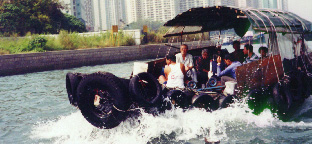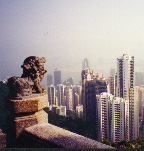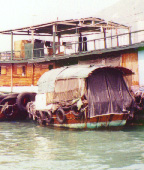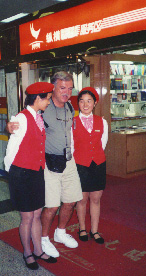







|
 A dragon's-eye view of modern Hong Kong from Victoria's Peak. |
When I woke up, Greg was already up and exploring the streets. I stopped back at the City Plaza Cafe for a Western buffet breakfast, meeting some more of the riders. There were two extremely outgoing balloonists from Mississippi, Richard and Johnny, who became the nominal ambassadors of our mission. Deborah came from Massachusetts where she was a health care administrator, and the irrepressible Jackie June--well, I'm not quite sure where she came from, but she certainly added a lively presence to the trip. Aside from my roommate Greg, the strongest riders would prove to be the three eldest. Charles Briner, a tall retiree whose second job appeared to be world travel, had been to Hong Kong before--starting in 1954. And then there were Bee and Bob of Seattle, both relatively new to cycling, but in great shape from Telemark skiiing. After breakfast, we went down to the lobby and waited for our tour guide, "Mr. Kevin." A portrait of Baden-Powell was hung ceremonially opposite the entrance. Across the room, marching through a row of ornamental plants was a statue of a man and two children in Chinese-styled uniforms; some Maoist Youth Brigade, I assumed, but then when I got close enough to read the legend, it referred to the Chinese Boy Scouts. Hmmmm, I thought, always got to be cautious about these youth groups.
|

Rolling and tumbling in a kayak works pretty much the same way, whether it's East or West.
|
Mr. Kevin turned out to be a small hyper-energetic man in blue jeans who spirited us off on a whirlwind tour of the island city interspersed with factoids and random observations. Our first stop was Victoria's Peak, which gave us a good overlook of the high-rises below, and the harbor inexorably narrowing as trucks and bulldozers slowly pushed the shoreline further out into the water. From there we dropped down the winding roads to Repulse Beach on the south side of island, an Oriental-style Coney Island with two grand cartoonish statues of the God of Heaven and the Goddess of Mercy. But by far the most popular statue was a relatively small one of the God of Wealth, where the passersby had queued up to rub it for good luck. It was already blazingly hot, so after walking out on a pedestrian causeway and photographing a small fleet of energetic kayak students, I headed back to the McDonald's/ KFC complex for iced lemon tea. |
|
|
|
|
 The Aberdeen fleet: varnished hulls and old tires for bumpers. |
Our next stop was the once-picturesque Aberdeen Fishing Village, now dwarfed by modern hotels and apartment buildings. This is where many of the exotic chase scenes involving junks and sampans are filmed, though it takes a very tight shot to avoid the hotels and corporate towers of modern Hong Kong looming everywhere. The fishing fleet is dwindling, Mr. Kevin told us, with fewer and fewer youngsters willing to follow in their fathers' wakes. He offered a figure of 20,000 for the community, with more and more hands being hired from the mainland. Mr. Kevin ushered us onto a small tourist junk for a 40-minute harbor tour through the odd (and yes, picturesque) collection of rusting trawlers, houseboats, smaller junks, and high-backed boats looking a little like Spanish galleons, with varnished wooden hulls ringed by old tires for bumpers. |
|
|
|
|

Jackie discovers MTV
on the Kowloon-Guangzhou train. |
By one o'clock we were at the modern train station going through the usual passport formalities and panic of trying to decipher and distinguish track numbers from train numbers, etc. The train itself proved to be marvelously comfortable, with plush seats, beverage service, head phones, and television. It was an hour and a half to Guangzhou through beautiful countryside, industrial bad lands, rural shacks, and run down apartment buildings. At the Guangzhou station we met one of our tour guides, Luk Wei Dong, a strapping young man speaking good English. He was thoroughly unflappable, with the easy confidence and charm of an athlete. We learned that we were at the Eastern railway station that communicated with the (degenerate) enclave of Hong Kong. The station for interior travel was separate, as was the airport. For some reason, our van was parked a good distance away, so we had our first walk through a Chinese city, where all shops open on the street. It already had a very different from the scrubbed sidewalks and enclosed shops of Hong Kong. As I passed one shop I saw a small pig lying in one bamboo cage and next to it a caged dog. I gathered that neither of them were destined to live out their lives as pets.
|
|
 Johnny practices diplomacy, Southern (China)-style, in the Guangzhou airport. (photo by deborah ruhe) |
We rode cross-town to the airport and I could see that this was still a city heavily influenced by the West, in some ways reminding me of Buenos Aires (my most recent excursion). If anything, there was an even greater proliferation of ads in English for high tech products and Western brand names. Another thing that distinguished Guangzhou from the other cities in our tour was the ubiquitous use of cellullar phones. The airport was elegantly modern and housed a neat little market, decorated brightly with neon, with fruits and nuts and dried snake, racks of luggage and bags, a selection of books, and toys. The second floor had much of the same merchandise, but in the small shops along an arcade. I was surprised to find most of the toy planes were US fighters and bombers, including the B-52, which had brought so much ordinance to Southeast Asia. When we came out the rear of the building, it was like stepping through a facade: the crowded cityscape was gone, only the long flat runways stretching into a distant vista of the mountain range ringing the city. A bus carried us out to a well-appointed airplane, where we alternated between watching television in Cantonese and dozing during the hour flight to Nanning. The van that met us at the airport was to support us through the Chinese part of the tour. This was our first meeting with the mastermind behind the trip, Su Zhi Wei (known to us as "G-way"). A banner had been affixed to the side reading "Welcome American Bicyclists to Nanning," with accompanying Chinese translation. (Well, I think it was the same message, though for all I know it might have said "Caution &endash; Unpredictable Foreigners on Board.") As we rode into town, another gentleman, Mr. Muoi, gave us a welcoming address on behalf of the Chinese-American Friendship Association of Nanning. (My mother having been a member of a Chinese-American Friendship Association in Washington, I've developed a healthy warning sense about the word "friendship," which tends to be attached to a relationship that needs delicate handling.) Mr. Muoi explained that this was a relatively small Chinese city of 200-300 million. After a moment of stunned silence, further inquiry led to a downward adjustment of that figure to 2-3 million. Either way, it was a busy place at all hours. The van carried us through heavy nighttime traffic of bicycles, cyclos, motorbikes, and cars, across the broad river known as the Yongjiang, and into the compound of the palatial Yongjiang Hotel for a late dinner of increasingly authentic and challenging cuisine. |